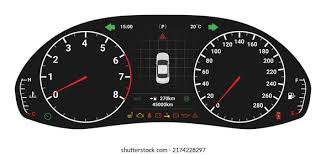


This article will explain you how the instrument cluster works and why we need to have one in each vehicle.
The instrument cluster is located at the heart of all automobiles providing the driver with vital knowledge about the performance and situation of the vehicle. Just behind the steering wheel, this array of gauges and displays is essential for safe and effective driving. Whether you’re tracking speed, fuel level, or monitoring engine health, the instrument cluster offers up-to-date info for smooth driving.
Speedometer: The speedometer is perhaps the most familiar reading in the instrument panel. It shows the vehicle’s speed, thus allowing the driver to drive legally at a legal and safe speed.
Tachometer: The tachometer indicates the RPM of the engine. By slewing this gauge, drivers will be able to keep track of whether they are over-extending the engine, leading to mechanical failures.
Fuel Gauge: The fuel gauge will show you the remaining tank of gas. It’s essential when making plans for long distance drives and ensuring that drivers do not run out of gas at random.
Temperature gauge: This reads the engine coolant temperature which informs the driver when the engine is too hot. Overheating is potentially catastrophic to the engine, so it’s best to watch this gauge closely.
Odometer: The odometer indicates the vehicle’s mileage. trip meters in modern digital clusters make it possible for the driver to log discrete trips.
Warning Lights: Aside from the gauges, there are also a bunch of warning lights located in the instrument clusters. These include the check engine light, oil pressure warning, battery warning and seatbelt warning. These lamps aim to orient the driver and signal any issue or potential issue in real time or the future.
Analog Instrument Cluster: The analog clusters are most classical, using mechanical dials indicating speed, RPM, and fuel amount via needles. Effective but constrained in the information it shows at any given time.
Digital Instrument Cluster: Most newer cars are now available with completely digital instrument clusters, making the experience more programmable. Digital clusters also can display a lot more data, and are often configurable by the driver to show certain metrics, such as gas mileage, driving directions or even entertainment options.
Hybrid Clusters: A few cars have a hybrid cluster which combines both analogue and digital gauges. Drivers enjoy the feel of a dial, with added information available on digital displays.
Apart from real time driving information, the instrument cluster is vital for diagnostics. The cluster has warning lights, telling the driver if an oil is low or more serious, like a malfunctioning engine. By warning drivers about problems before they arise, the instrument cluster prevents breakdowns and high-priced repairs.
Even the design of the instrument cluster has been updated in a way that makes the vehicle safer. The digital clusters of today are capable of overlaying additional safety alerts like lane departure warnings, collision warnings and even blind spot detection. These devices coordinate with the instrument cluster to provide the drivers with information and drive safe.
Digital Cluster customization: Today’s digital clusters can be completely customized, enabling drivers to set what information they want to prioritize. These can be maps, statistics, or even entertainment features.
Safety: Newer cars have instrument clusters that are often paired with high-tech safety technologies, displaying anything from lane change to a forward collision alert. This keeps drivers on their toes.
Efficiency: By providing fuel efficiency information, today’s instrument clusters assist in driving more effectively for greater mileage and emissions. This is particularly useful for the more environmental conscious drivers looking to minimise their carbon footprint.
Simpleness: All your instruments are displayed in one place making the instrument cluster unrivaled in ease. Drivers no longer need to glance at a handful of monitors or buttons, so you don’t distract and can concentrate better.
Schluss.
The instrument cluster is the most important part of any car because it’s what allows the driver to make a decision about how best to drive their car. Through analog dials or modern digital display, the cluster acts as the heart of vehicle information — educating the driver on speed, fuel, engine performance, and more.
